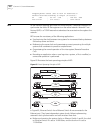
278 CHAPTER 11: SYSTEM MANAGEMENT
Dropped packet events (due to lack of resources):0
Packets received according to length (in octets):
64 :644 , 65-127 :518 , 128-255 :688
256-511:101 , 512-1023:3 , 1024-1518:0
NTP As the network topology gets more and more complex, it becomes important to
synchronize the clocks of the equipment on the entire network. Network Time
Protocol (NTP) is a TCP/IP feature that advertises the accurate time throughout the
network.
NTP ensures the consistency of the following applications:
■ Synchronizing the clock between two systems for incremental backup between
the backup server and client.
■ Referencing the same clock and guaranteeing correct processing for multiple
systems that coordinate to process a complex event.
■ Guaranteeing the normal operation of the inter-system (Remote Procedure
Call).
■ Recording an application when a user logs into a system, a file is modified, or
some other operation is performed.
Figure 65 illustrates the basic operating principle of NTP:
Figure 65 Basic Operating Principle of NTP
In Figure 65, Ethernet Switch A and Ethernet Switch B are connected to the
Ethernet port. They have independent system clocks. Before implementing
automatic clock synchronization on both switches. Note that:
■ Before synchronizing the system clocks on Ethernet Switch A and B, the clock
on Ethernet Switch A is set to 10:00:00am, and the clock on B is set to
11:00:00am.


















